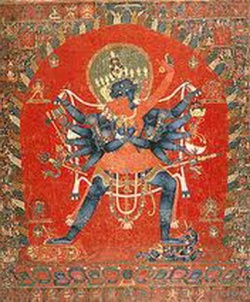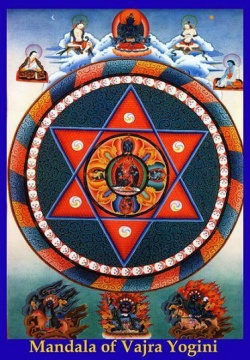Anuyoga
Anuyoga (Skt. अनुयोग 'further yoga') is the designation of the second of the three Inner Tantras according to the ninefold division of practice used by the Nyingma school of Tibetan Buddhism. As with the other yanas, Anuyoga represents both a scriptural division as well as a specific emphasis of both view and practice.
Position in the nine-yana schema
Anuyoga is said to emphasise the completion stage of Tantra, where the preceding division, Mahayoga emphasises the generation stage. Dalton (2003: unpaginated) in introducing the literature of the Anuyoga-yana affirms the affiliation of the Anuyoga-yana with the 'completion stage' or the 'perfection stage':
Modern-day doxographical presentations of the Nyingma school are usually based on the system of the nine vehicles (theg pa dgu). Emphasis is placed on the highest three vehicles in this scheme, namely Mahāyoga, Anuyoga, and Atiyoga. Generally speaking, these three “inner” yogas correspond to three stages in tantric practice, namely the generation stage, during which the details of the visualizations are stabilised, the perfection stage, in which those visualizations are then employed towards familiarizing oneself with the state of enlightenment, and finally the Great Perfection, the spontaneous accomplishment of buddhahood. Being the second of the three inner yogas, Anuyoga is thus associated with the practices of the perfection stage.
Ray (2002: p. 124-125) mentions visualization, subtle body, chakra, prana, nadis, bindu and pure land:
Anuyoga-yana is associated with the feminine principle and is for those whose principal obstacle is passion. In anuyoga the emphasis shifts away from external visualization toward the completion stage, in which one meditates on the inner or subtle body with its primary energy centres (chakras), and its prana (winds or subtle energies), nadis (the inner pathways along which one's energy travels), and bindu (the consciousness). In anuyoga, all appearances are seen as the three great mandalas, and reality is understood as the deities and their pure lands.
Germano (2002: unpaginated) frames the importance of Nub Sangye Yeshe as the instigator of Anuyoga within Tibet and states that it was: "the late ninth century Nub Sangye Yeshe (gnubs sangs rgyas ye shes), who inaugurated the Anuyoga tradition in Tibet...".
Dudjom (1904-1987), et al. (1991: p. 460 History) relate an important source that impacts on the story of King Ja (particularly the narrative of the Buddhadharma relics falling from the sky upon the royal palace) a happenstance which is implied to be concurrent with the emergence of the texts of Anuyoga in Sri Lanka with the provision of a quote of what Dudjom et al. identify as a "prediction" found in the fifth chapter of the 'Tantra which Comprises the Supreme Path of the Means which Clearly Reveal All-Positive Pristine Cognition' (Wylie: kun bzang ye shes gsal bar ston pa'i thabs kyi lam mchog 'dus pa'i rgyud, Nyingma Gyubum Vol.3) which Dudjom, et al., render in English thus:
The Mahayoga tantras will fall onto the palace of King Ja. The Anuyoga tantras will emerge in the forests of Singhala [Dudjom et al. identify Singhala as located in Ceylon].
View
The particular view of Anuyoga is to realise the essence of the 'Threefold Maṇḍala of Samantabhadra' (Wylie: kun tu bzang po dkyil 'khor gsum):
"empty basic space" (Wylie: skyes med pa'i dbyings): the 'Primordial Maṇḍala of Samantabhadrī' (Wylie: ye ji bzhin pa'i dkyil 'khor)
"wisdom" (Wylie: Ye shes): the 'Natural Maṇḍala of Spontaneous Presence'(Wylie: rang bzhin lhun grub kyi dkyil 'khor)
"union of emptiness and wisdom" (Wylie: chos kyi dbyings kyi ye shes): the 'fundamental Maṇḍala of Enlightenment' (Wylie: byang chub sems kyi dkyil 'khor)
Stated differently:
The three mandalas of: Kuntuzangmo, the unborn dharmadhatu (dByings skye med kun tu bzang mo’i dkyil ’khor); whose unobstructed skillful means of luminosity is the mandala of Kuntuzangpo, the yeshe wisdom (Ye.shes kun tu.bzang po’i dkyil ’khor); and their inseparable union is the mandala of Great Bliss their son (Sras bde ba chen po’i dkyil ‘khor).
Texts
Anuyoga is the middle category of the inner Tantras for the Nyingma school. This doxographical category, often called 'mdo' (Wylie; Sanskrit: sūtra; English: 'thread', 'continuity'), is not to be confused with the non-Tantric category by the same name. It contains several works that designate themselves as sūtras, as well as the important text "Compendium of the Buddhas' Intentionality" (Sanskrit: Sarvatathagata svabhabhi sasa tantra, Wylie: sangs rgyas dgongs 'dus) or Compendium of the Intentions (Wylie: dgongs pa ’dus pa’i mdo). This text which may or may not have ever existed in India; according to the colpohon it was translated from the language of Gilgit (bru sha), from whence all of the Anuyoga texts are said to have been brought to Tibet.
Altogether, there are three volumes of Anuyoga tantras amounting to nearly three thousand pages of Tibetan text. Although the mTshams brag edition of The Collected Tantras does not rigorously organise its texts according to sub-categories, the Anuyoga category may be further subdivided according to the following scheme from Dudjom Rinpoche (Dudjom, et al. 1991: p. 289) which varies from the earlier catalogues canonised by Jigme Lingpa and that of Dampa Deshek:
The four root sutras (Wylie: rtsa ba'i rgyud bzhi)
The six tantras clarifying the six limits (Wylie: mtha’ drug gsal bar byed pa’i rgyud drug)
The twelve rare tantras (Wylie: dkon rgyud bcu gnyis)
The Seventy Literary Scriptures (Wylie: lung gi yi ge bdun cu)
The four root sutras (Wylie: rtsa ba’i mdo bzhi)
Compendium of the Buddhas' Intentionality (Sanskrit: Sarvatatathagata svabhabhi sasa tantra, Wylie: sangs rgyas dgongs 'dus) or Compendium of the Intentions (Wylie: dgongs pa ’dus pa’i mdo)
Knowing of All the Gathered (Wylie: kun ’dus rig pa’i mdo)
Play of the Charnel Ground Cuckoo (Wylie: dur khrod khu byug rol ba)
Majestic Wisdom’s Wheel of Lightning (Wylie: ye shes rngam pa klog gi ‘khor lo)
The six tantras clarifying the six limits (Wylie: mtha’ drug gsal bar byed pa’i rgyud drug)
kun tu bzang po che ba rang la gnas pa’i rgyud
dbang bskur rgyal po
ting ’dzin mchog
skabs sbyor bdun pa
brtson pa don bden
dam tshig bkod pa
The twelve rare tantras (Wylie: dkon rgyud bcu gnyis)
zhi ba lha rgyud
chos nyid zhi ba’i lha rgyud
khro bo’i lha rgyud chen mo
khro bo’i lha rgyud rtogs pa chen po
thugs rje chen po’i gtor rgyud (terminating colophon of the Catalogue of the Rig 'dzin Tshe dbang nor bu rNying ma'i rgyud 'bum
rnal ’byor gsang ba’i tshogs rgyud chen po
dpal ’bar khro mo
rak ta dmar gyi rgyud
me lha zhi bar gyur ba ’bar ba’i rgyud
khro bo’i sbyin bsregs rdo rje’i dur mo
hum mdzad chen mo
zla gsang chen mo
The Seventy Literary Scriptures (Wylie: lung gi yi ge bdun cu)
This list remains to be enumerated.
Mindstream
The 'mind-stream doctrine' (Sanskrit: citta santana; Wylie: thugs rgyud; sems rgyud) is a union of the 'Mind Cycle' (Wylie: sems sde) of Atiyoga and Anuyoga proper and is reinforced by the Guhyagarbha Tantra literature and the Kulayarāja Tantra which comprised a major part of the transmitted precepts of the 'Zur Lineage' (Wylie: zur lugs):
This family was responsible for first formulating the transmitted precepts as such. In doing so, they made the Compendium Sūtra a major part of their system, placing it alongside the Guhyagarbha Tantra and the kun byed rgyal po to make their famous “sūtra-tantra-mind triad” (mdo rgyud sems gsum). These three works became the chief canonical texts of the Zur’s transmitted precepts, corresponding to the respective doxographical classes of Anuyoga, Mahāyoga, and the Mind Class of Atiyoga (sems sde).


